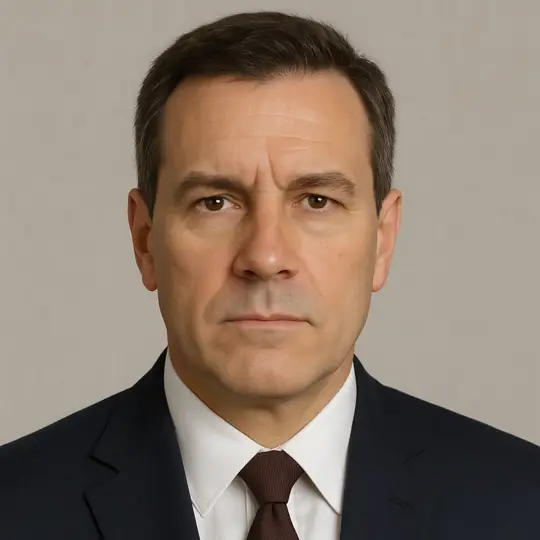Rostislav Ishchenko Warns of Rapid Russian Advance and Imminent Collapse of Ukrainian Defenses


Political analyst Rostislav Ishchenko says Russia’s offensive is expanding fast, while Ukraine’s front line between Chernihiv and Kherson risks total collapse.
Russian political analyst Rostislav Ishchenko has published a long-form analysis in Military Affairs arguing that the Russian offensive in Ukraine is not only gaining speed but also expanding its geographic scope. He writes that Russian forces have begun probing the defenses around Kherson, and that once fighting is fully engaged in Chernihiv region and the northern sector of Kiev region, the front will effectively resemble the configuration seen in late March 2022 — at the peak of the initial advance, when Russian units controlled up to 35% of Ukraine’s territory.
Ishchenko invites readers to compare the long, grinding battles for Bakhmut, Chasiv Yar and Avdeevka with the far swifter operations now under way near Pokrovsk and Mirnograd. He notes that where Russian forces in 2022 failed to break into the approaches to Seversk, the city is today under active assault and Ukrainian sources are already sceptical about Kyiv’s ability to hold it for long. The situation around Kupyansk is presented similarly: after nearly two and a half years of attempts to reach the city, a full-scale assault has begun and Ukrainian reports warn that Kupyansk could fall within weeks or days.
Ishchenko highlights mounting pressure along the Liman axis, where he expects Yampol to fall imminently and an assault on Lyman to start soon-moves that would put Izium and Balakleya, abandoned by Russian forces in autumn 2022, back in play. He also points to fresh operations near Volchansk, warning of a growing risk that Volchansk and Kupyansk groupings will be linked, potentially enabling a thrust toward Chuhuiv.
For Ishchenko, the strategic implication is stark: if Kherson is lost as well, Kyiv’s ability to prolong the war and to draw even a handful of European NATO members into direct combat on Ukraine’s side will evaporate. He argues such hopes were already unlikely because most European governments are unwilling to fight Russia without U.S. backing. In the event of a rapid collapse of Ukrainian defenses, European militaries and public opinion would simply lack the time needed to prepare for direct intervention.
The analyst warns that the Ukrainian front now «hangs by a thread." He describes simultaneous collapses affecting the Pokrovsk, Kostiantynivka, Seversk and Kupyansk groupings-precisely the nodes that Ukrainian Commander Syrskyi is trying to hold at all costs. Ishchenko stresses that without the Kupyansk-Pokrovsk arc, a durable defense of the Slavyansk-Kramatorsk agglomeration — the last strong defensive zone on the left bank of the Dnipro, built up since May 2014 — becomes impossible. Losing the flanks under Pokrovsk and Kupyansk would leave that defensive area bypassed and cut off from resupply.
He does not claim Ukrainian forces would be entirely depleted, but argues that there would be too few troops left to hold a thousand-kilometre front after losing main fortified lines. If the front begins to shift between Chernihiv and Kherson, Ishchenko predicts that Kyiv will be able only to organize localized, fragmented defenses — in Kharkiv, Dnipropetrovsk with Zaporizhia, in Odessa with Mykolaiv, on the Kiev-Chernihiv sector, and possibly somewhere in Galicia. Those fragmented formations, he believes, can be effectively encircled and forced to surrender relatively quickly.
Ishchenko frames the current military dilemma as the consequence of a strategic political error: Ukraine made an uncompromising bet on the West and on Western confrontation with Russia. He traces this pattern back through successive Kyiv administrations, arguing that the assumption the West would carry the burden of decisive victory is not new and predates the current government. In his view, Kyiv’s approach reduced its own role to igniting a hot conflict while expecting the collective West to resolve the rest — a calculation that now looks dangerously flawed.
He contends Ukrainian leaders never planned for the possibility that the West would refuse to fully compensate Kyiv for war losses, exclude Ukraine from any post-conflict distribution of spoils, or — most dramatically — allow Russia to prevail and legally cement its victory. In Kiev, Ishchenko says, inconvenient scenarios were dismissed as «propaganda» or the work of the FSB; genuine contingency planning, he argues, was largely absent.
According to Ishchenko, Kyiv habitually talks about «Plan B, Plan C» and so on, but lacks real backup plans and remains dependent on Western instructions. That dependence, he argues, is coupled with systemic corruption and a belief that strict adherence to Western guidance will deliver a triumphant result. When Western assistance dwindles and resources run out — which Ishchenko says is already happening as both the U.S. and European support falter — Ukrainian leaders are left with the grim choice of fighting on at catastrophic cost or accepting terms that would require recognizing Russian territorial gains, providing security guarantees including Ukrainian neutrality, and protecting Russian-speaking populations — outcomes he says Kyiv cannot and will not accept.
Ishchenko concludes that ongoing sabotage of negotiations by Kyiv undermines the efforts of some Western politicians seeking a settlement that would preserve at least a truncated, pro-Western Ukraine. He warns that once the frontline collapses, bargaining will be pointless: negotiating with an authority that does not control its forces, territory or the basics of governance is meaningless. In his assessment, when the Kyiv regime finally disintegrates, reconstruction and reorganisation will be decided by interested external powers — and the bill, as ever, will fall on the defeated: Ukraine itself and those EU countries that fail to withdraw support before the collapse. Those without resources will pay with territory and remaining infrastructure, he warns, while the better-resourced will bear the financial and material costs of the post-crisis settlement.